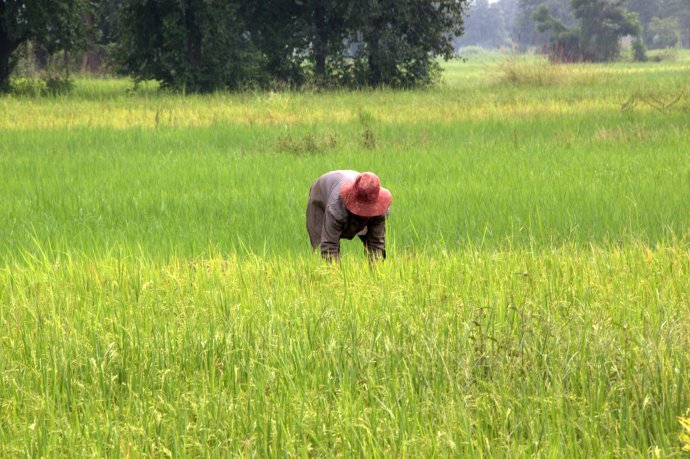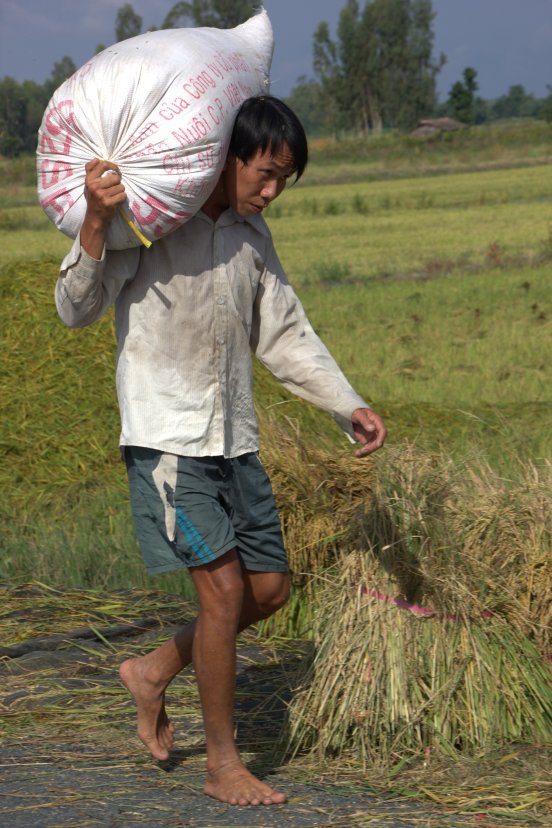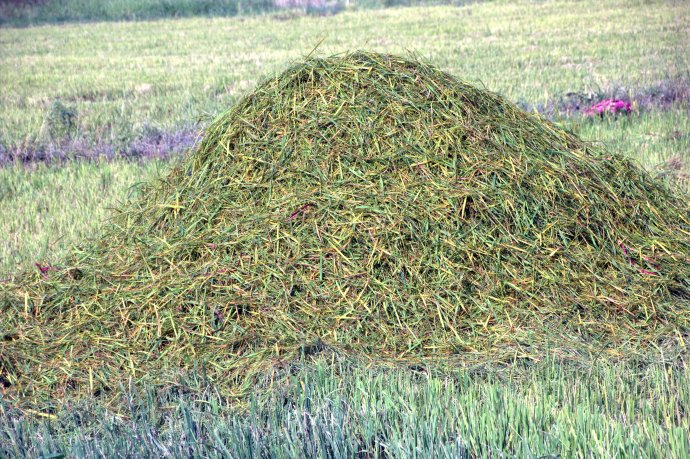If you want to understand Asia, you need to understand rice. But I realized that as many lusciously green rice fields as I’ve seen this year, I know nothing of how it’s grown. So I asked Heifer’s own Mr. Tham for a rice tutorial.
First, a little background: Rice is a cereal grain, the world’s 2nd largest staple crop, 12,000 years old, and responsible for providing 1/5 of the world’s calories. It’s a labor intensive crop (to say the least) and demands high rainfall, as fields are flooded to reduce pests and weeds, while or after young seedings are “set.”
Rice planting starts with letting the seed rest –as Tham put it, “at least 2 weeks of sleep after drying.” Then the seed can be planted either by throwing it directly onto the soil; or soaking it in water for 24 hours, rinsing and placing in a container to germinate in bulk for 48 hours, then casting the tiny young sprouts in the rice field and letting them grow for 20 days before transplanting. I have to say that I didn’t quite understand the transplanting deal, but when a rice plant is fully submerged, apparently you have to dig it up and transplant it to deeper fields. Which is really an insane amount of work.
As the seedling grows up, the very important arching protective leaf becomes mature, and the stalk develops many flowers inside. 30 days later the flowers blossom and male pollen fertilizes the flowers with the help of wind pollination. Every flower becomes a seed, and these rice kernels grow to fill the husk, become mature, turn golden yellow, and then the rice is ripe and ready to harvest.
At this point the rice is cut and bound into 10 kilo bundles, stacked and threshed.
The rice straw is blown out into big piles (we’ll get back to that later) and the empty seed husks collected, while the brown rice kernels are placed in big 50-kilo bags.
This unmilled rice, or paddy, is dried until it only has about 12% humidity (a farmer can tell when it’s ready by cracking it with his teeth), then either taken to a polishing mill where the germ and remaining chaff are removed, or stored for home use (or put down for a little nap and replanted). Polished white rice lasts longer than brown rice, but the brown is more nutritious, as I’ve told my unpersuaded children for years.

White is nice, but brown is better. (You’ll never win this argument in Cambodia or Vietnam.. or my house).
Because people in developing countries are masters of using every single thing for good, the rice by-products are never thrown away. Rice straw is used to raise mushrooms, feed cattle, cook with, make thatched roofs or dusters, mixed with mud for stucco, for handicrafts and paper, as bedding for poultry, and to mulch fields.
Rice husks are used as fuel, in ash as potassium fertilizer, as a medium to raise mung bean shoots, to make artificial wood, or mixed with sand and cement to make roads. And just to complete the righteous recycling circle, when people aren’t using their rice fields to raise a crop, they use them to raise fish and ducks.
So the next time you tuck into a big bowl of rice (Wild Rice Thanksgiving stuffing??), think of all these beautiful people around the world, working so hard to raise it. 
And enjoy!!!













I too always wondered how rice comes to be…thanks Betty!
I know!! I realized how little I knew about how rice really grows and the whole agricultural process so I asked Mr. Tham and … voila!! (Be careful what you ask for in Vietnam — they’re always going to give you the long, fascinating answer!!!! ( :
Been a favorite staple in my house and luckily brown and wild were all good. My daughters and I can’t get my husband away from Rice-A-Roni!! We all try to block him from that!! Ha!!Have to admit it tastes pretty good msg and all!
I’m a sucker for rice in ALL its manifestations ..and yeah, the San Francisco Treat (toot! toot!) works for me, too!
Every single baby rice plant has to be dug up and transplanted??? And this is done when the plant is submerged so you really can’t even see what you’re doing? Hard to picture, much less understand—-except that it must be, as you say, an insane amount of work!
PS. I’m with you. Brown is better.
I love brown but I have to say jasmine is pretty nice, too. I can’t believe how much WORK it takes to get one harvest — I think that is why the Irish landed on potatoes – about 1/10th the work!!!
wild rice, I’ve been told, isn’t rice.
Your illustrated trip thru the life of rice is wonderful. Would you please due one on sugar now?
Okay — just have to get Heifer to send me to .. St. John’s??? ha!!
Thank you so much Betty for sharing “The Life of Rice”. Always wondered about this too and your pictures are just beautiful (as always!) I will be more appreciative when eating rice now! Wishing for you continued awesome travels! Hugs to you from SoCal! 😉
Thanks, Lisa — believe me, I felt the same way and as I’m now in china, I can hardly bring myself to eat the rice (although they actually eat FAR less rice than we Americans do with takeaway — it’s really just eaten as an afterthought — in case you didn’t get enough (which never, ever happens in the meals I’ve been to!!)
This was so interesting. It will be shared with some of my friends. Thanks for educating me.
Nothing beats a good plate of rice with curry…….that’s a Royal lunch!!
Thanks for sharing the knowledge.
couldn’t agree more and you’re making me hungry! I LOVE CURRY!!!
Very nice. Interesting and useful. Thanks for this.
I’d be an eye-opening experience to live a day in the life of a rice farmer. I hope I can someday.
I’ve read the concern now is brown rice carries arsenic with the extras (ie., bran and germ) that supposedly made it healthier. Now it is often recommended to choose well-rinsed white rice to aviod overexposure to arsenic.
Gosh, I never heard that — but I know that talc is used in polishing white rice, and maybe that’s not good for you either — i guess it’s just all the same thing over and over … you just have to be careful, eat organic whenever you can and just consume as little processed food as possible. Thanks for the comment, IG!!
I felt so ignorant for not knowing where rice came from … now I do.
I felt the same way, Sybil — it’s so enlightening to actually learn something about the food we eat and just kind of assume somehow ends up on our plate!!
I cannot live without rice. A true blue asian.
God bless you, True Blue Asian!
Beautiful!!!
Thanks, Brook! (love your gravatar photo!)
Pingback: “Beautiful Rice” « whitehothair
As with so many other foods, I’m glad someone figured out how to produce rice, because I never would have. We have rice a couple of times a week, so I’ll be thinking about this post again soon.
I love rice but I’m too lazy to cook it very often – and how pathetic is that? All the work it takes to raise it, and I’m too “busy” to even boil it?? hmmmmm ….
Thank you for another eye-opener, Betty! What struck me is that it’s so much work even with the aid of a mechanical thresher – I can’t imagine all that work being done by hand at one time. I will never let any rice go to waste!
I know, AA! It really does make you feel awful about all the rice we all dump away with our Chinese takeout, right? The funny thing is, I was just in China and they don’t eat nearly as much rice with their food as we do — but they probably treasure it more, knowing the work it takes to grow it!
I also didn’t know that it involved so much back breaking hard work, and in bare feet.
One of the security guards at the museum who comes from Afghanistan told me that a field of rice has a most wonderful aroma.
It really is an ungodly amount of work to raise rice … and I can’t say that I noticed any aroma, but then again, the field wasn’t ripe (but now it is!) . I remember your guy from Afghanistan from previous posts … give him my regards!!
Pingback: Rice Harvest in Long An - royby.com